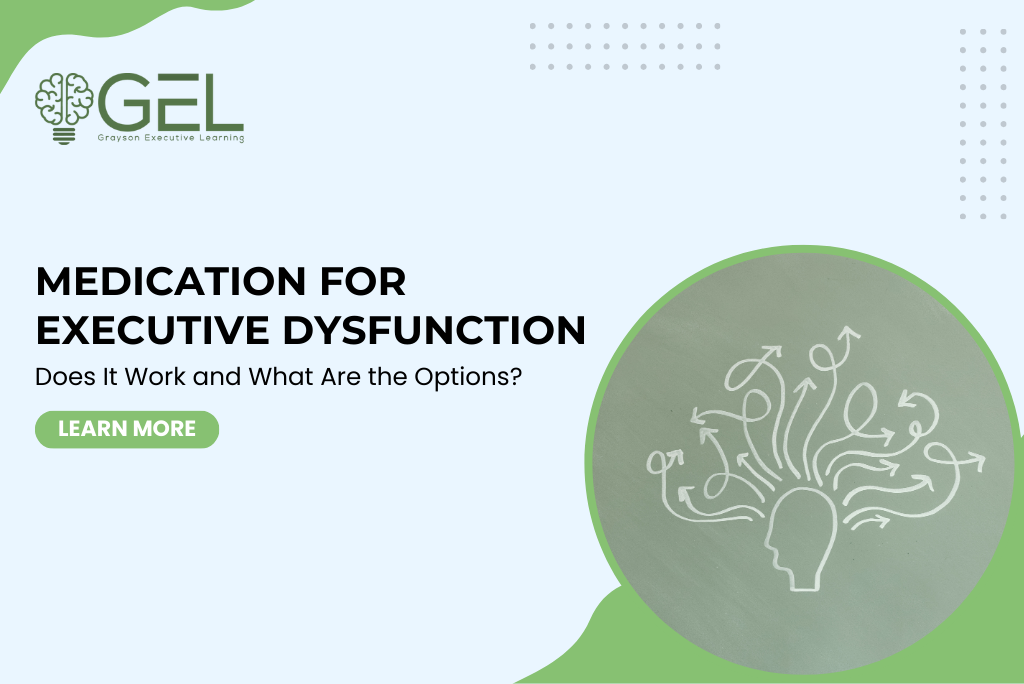You know that feeling when your brain refuses to cooperate, no matter how badly you need it to? You have deadlines, responsibilities, and people counting on you, but getting started feels impossible. That’s what executive dysfunction is like. It’s not just about being forgetful or distracted; it’s a real struggle that can make school, work, and daily life overwhelming.
For many people, executive dysfunction is linked to conditions like ADHD, autism, or brain injuries. It makes things like planning, staying organized, and following through on tasks incredibly difficult. Strategies like structure, coaching, and therapy can help, but sometimes they aren’t enough. That’s when medication may be an option.
Does it work? Sometimes. Is it a perfect fix? Not exactly. Let’s break it all down: how medication works, what the options are, and what to consider before making a decision.
How Medication Helps with Executive Dysfunction
Medication doesn’t make executive dysfunction disappear, but it can help people focus, stay organized, and follow through on tasks. Most medications work by increasing dopamine and norepinephrine levels, two brain chemicals that help regulate motivation, impulse control, and attention.
There are two main categories of medication used for executive dysfunction: stimulants and non-stimulants.
Stimulants: The Most Common Treatment
If you’ve heard of Adderall, Ritalin, or Vyvanse, those are stimulant medications. They’re the most commonly prescribed treatment for ADHD and executive dysfunction, and for good reason, with research showing that about 80 percent of people with ADHD experience noticeable improvement when taking them. For many, these medications can offer the mental clarity and focus they’ve been struggling to find, making day-to-day tasks feel more manageable.
Types of Stimulants
- Methylphenidates (Ritalin, Concerta, Daytrana)
- Used for ADHD-related executive dysfunction symptoms
- Available in immediate-release and extended-release forms
- Amphetamines (Adderall, Vyvanse, Dexedrine)
- Known for lasting longer than methylphenidates
- Helps with focus, impulsivity, and task completion.
Possible Side Effects of Stimulants
Of course, like any medication, stimulants aren’t without their downsides. While they can be incredibly effective, some people experience side effects that can feel just as challenging as the symptoms they’re trying to manage. It’s important to be aware of what to watch for and to work closely with a doctor to find the right balance.
Possible Side Effects of Stimulants:
- Loss of appetite
- Difficulty sleeping
- Increased heart rate and blood pressure
- Mood swings or irritability
- Anxiety or nervousness
In addition to these, some people notice what’s called a “rebound effect” when the medication wears off. It’s like hitting a wall – suddenly feeling drained, irritable, or unable to focus again. If this happens, don’t worry – it’s common and can often be managed by adjusting the dosage or switching to an extended-release version under a doctor’s guidance.
Non-Stimulant Medications: The Alternative
Not everyone does well with stimulants. Some experience side effects that are too disruptive, or they may have medical conditions that make stimulants risky. If that’s the case, it doesn’t mean you’re out of options. That’s where non-stimulant medications come in.
Non-stimulants do not have the same risk of dependency and tend to work by increasing norepinephrine levels in the brain. They’re a gentler, slower approach, and while they may take a little longer to show full effects, with patience and the right guidance, they can make a meaningful difference.
Types of Non-Stimulants
- Norepinephrine Reuptake Inhibitors (Strattera – Atomoxetine)
- Helps improve focus and impulse control.
- Takes a few weeks to reach full effectiveness.
- Alpha-2 Adrenergic Agonists (Intuniv – Guanfacine, Kapvay – Clonidine)
- Originally developed for high blood pressure
- Helps with emotional regulation and impulse control.
- Sometimes prescribed alongside stimulants
Possible Side Effects of Non-Stimulants
Like any medication, non-stimulants can come with side effects, but knowing what to expect can make it easier to manage and adjust as needed.
- Fatigue or drowsiness
- Dizziness or low blood pressure
- Dry mouth
- Stomach discomfort
Since non-stimulants take longer to kick in, it’s completely normal to feel a bit frustrated in the beginning. It can feel like you’re waiting for things to “click.” But for those who can’t tolerate stimulants or need a gentler approach, non-stimulants can offer steady, reliable support once they’ve had time to build up. It’s all about finding what works best for your body and your needs – sometimes, slow and steady wins the race.
What About Antidepressants?
Antidepressants are not officially approved for treating executive dysfunction, but doctors sometimes prescribe them off-label, especially when someone also struggles with anxiety or depression.
- Norepinephrine-Dopamine Reuptake Inhibitors (NDRIs) (Wellbutrin – Bupropion)
- Works similarly to stimulants by increasing dopamine and norepinephrine.
- Can help with motivation and focus.
- Selective Serotonin Reuptake Inhibitors (SSRIs) (Prozac – Fluoxetine, Zoloft – Sertraline)
- Primarily used for depression and anxiety.
- Not typically effective for executive function alone
If someone’s executive dysfunction is closely linked to depression or anxiety, antidepressants might help. However, they are not usually the first choice for executive dysfunction alone.
How to Decide If Medication Is Right for You
Finding the right medication takes time, trial and error, and ongoing adjustments. Everyone’s brain and body respond differently, and it’s okay if it takes a few tries to get it right. A few key factors to consider:
- How severe are your symptoms? If executive dysfunction is making daily life unmanageable, medication might be a good option.
- Can you tolerate side effects? Some people handle medication well, while others struggle with sleep issues, appetite changes, or mood swings.
- Do you have other health conditions? Anxiety, depression, or heart conditions can impact which medications are safe and effective.
- What is your lifestyle like? Work schedules, diet, and sleep habits all play a role in how well medication works.
If you’re considering medication, know that you don’t have to figure it out alone. Working closely with a doctor you trust can help you find the option that feels right for you – one that supports your well-being, your goals, and your daily life.
Medication Is Only One Piece of the Puzzle
Medication can be helpful, but it’s not the only answer. Think of it as one tool in a larger toolkit. It works best when combined with behavioral strategies, structure, and self-awareness. Learning how to manage executive dysfunction often means weaving together different supports – because lasting change comes from both the inside out and the outside in.
Here are a few other proven tools that can complement medication and support long-term success:
- Cognitive Behavioral Therapy (CBT): Helps develop coping strategies for executive dysfunction.
- Executive Function Coaching: Personalized strategies for managing time, organization, and planning.
- Mindfulness and Meditation: Improves focus, reduces stress, and enhances flexibility in thinking.
- Diet and Exercise: Regular movement and balanced nutrition can boost brain function.
For many people, a combination of medication and behavioral strategies is the most effective approach.
When to Seek Professional Help
If executive dysfunction is getting in the way of work, school, or daily responsibilities, it is worth talking to a doctor. Reaching out can feel like a big step – but it’s a sign of strength, not weakness. You don’t have to keep struggling alone.
They can assess symptoms, run diagnostic tests, and create a treatment plan that fits your specific needs. Tools like the Barkley Deficits in Executive Functioning Scale or the Comprehensive Executive Function Inventory can help pinpoint challenges.
Final Thoughts
Executive dysfunction can feel frustrating and overwhelming, but support is out there. Medication can be a powerful tool for improving focus, impulse control, and organization, but it is not a magic fix.
For most people, the best results come from combining medication with structure, coaching, and lifestyle changes.
If you or someone you love struggles with executive dysfunction, take that first step. Talk to a professional, explore treatment options, and find what works best for you. With the right support, managing executive dysfunction is absolutely possible.
How Can GEL Help?
Grayson Executive Learning (GEL) is a boutique Academic and ADHD\Executive Function Coaching practice that specializes in providing premium one-on-one academic coaching services to high school and college students with ADHD and executive function difficulties.
Click here to learn how we can help your student truly reach their academic potential while developing critical life and independence skills.
We look forward to serving you!




